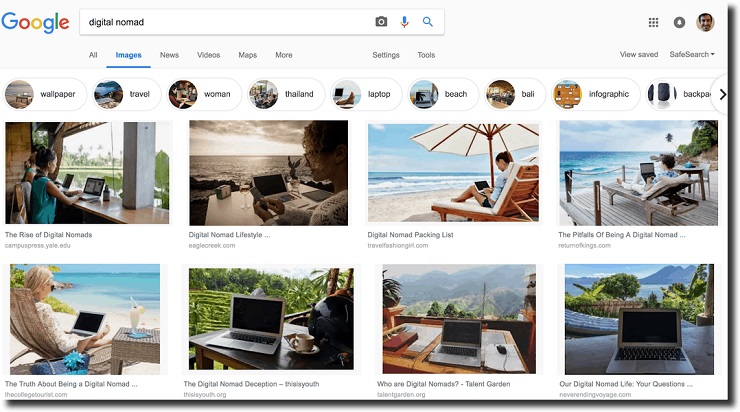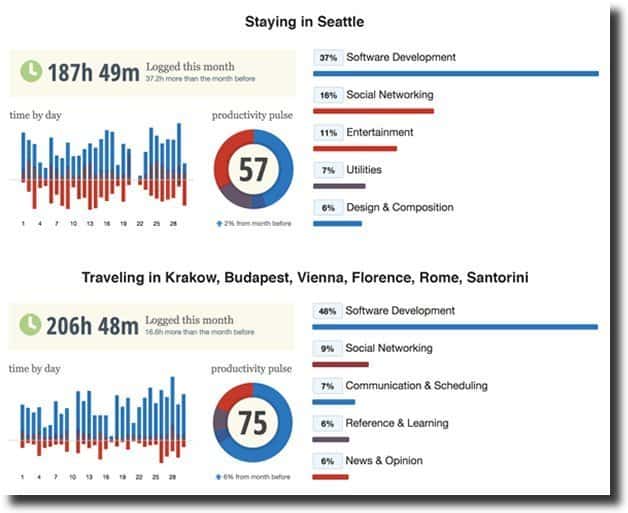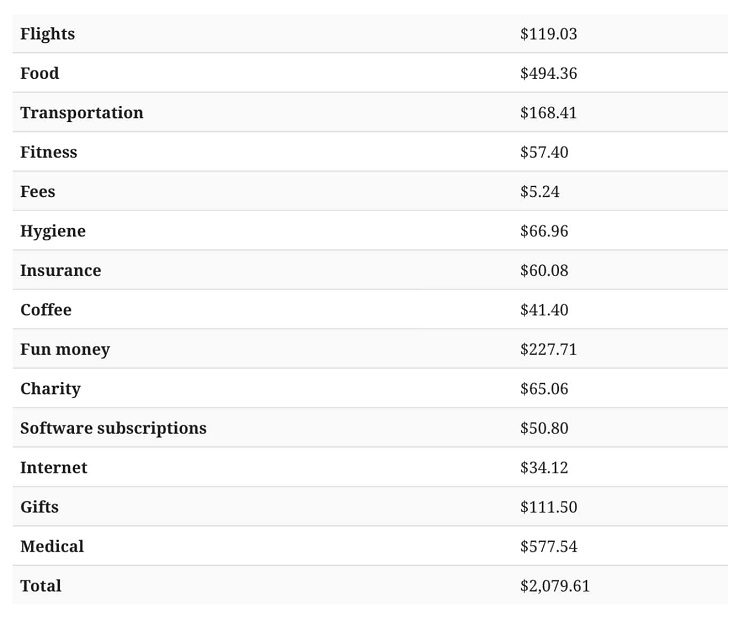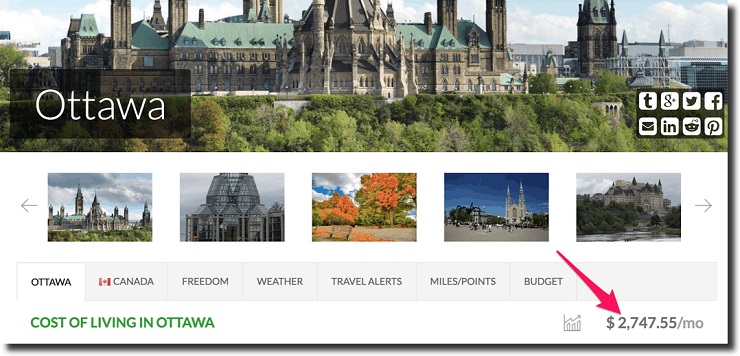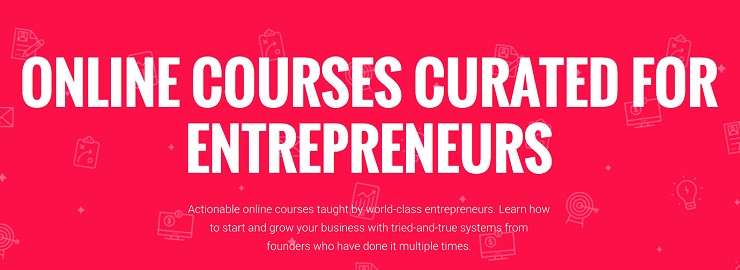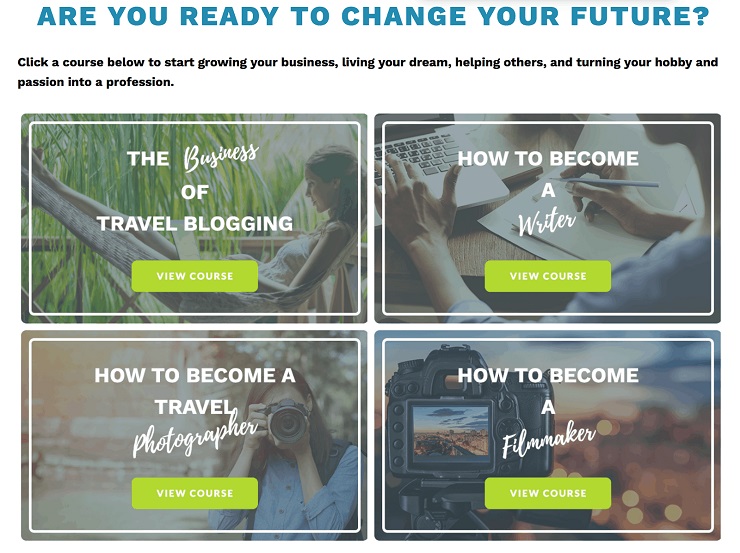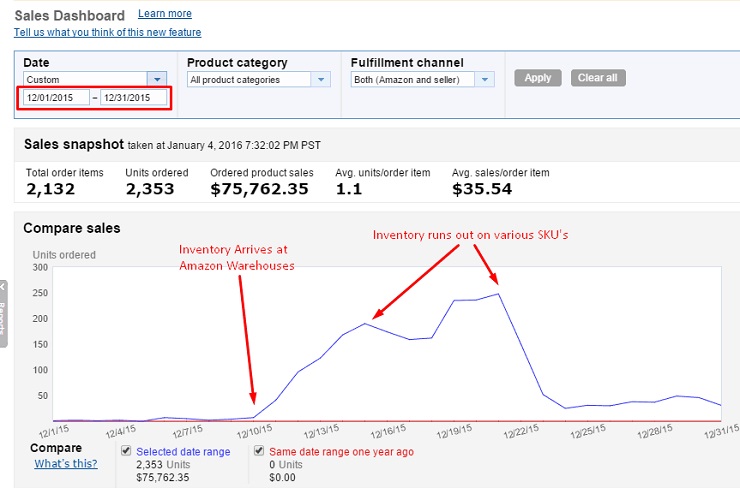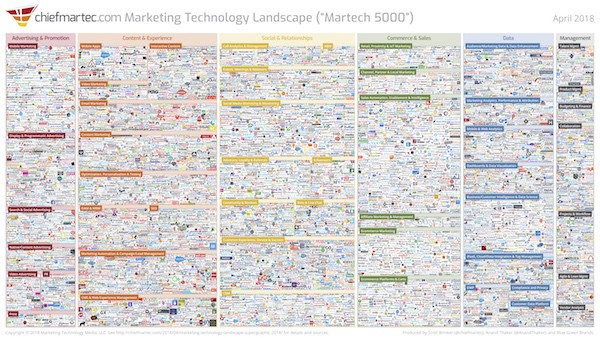What would you do if money wasn’t a concern?
Two years ago, my best friend asked me that very same question. Honestly, it stopped me in my tracks. After thinking it over for a minute, I said, “I’d travel the world, visit many beautiful places, and spend more time enjoying life.”
“Then why aren’t you already doing it?” he replied. “You already work remotely!”
Wait a second, I thought. Did that mean I could travel the world while growing my content writing consulting business?
As it turned out, I could, and I’m willing to be that you can too.
Building a business as a digital nomad—someone who works entirely online, from anywhere with an internet connection—is possible and more common than you might think. It can also be a highly rewarding experience, both professionally and spiritually.
Not only do I believe you can do this, but I will show you based on my own experience and what I’ve learned from others how to become a successful digital nomad and start building your online business today.
Let’s jump right into it.
Table of Contents
3 Myths Stopping You From Traveling the World
The Digital Nomad’s Perfect Business
How to Become a Digital Nomad and Build a Business While Traveling the World
Become a Digital Nomad
Embracing the Digital Nomad Lifestyle: 3 Myths Stopping You From Traveling the World
The word “digital nomad” makes many people think about slackers who live on the beach while working two hours a day. Take a look at the results Google images returns after a quick search:
Actually, a digital nomad is nothing more than a location-independent worker—whether the founder of their own company, an independent consultant, freelancer, or remote employee—and uses technology to perform their job on the go.
There’s nothing in there that says you need to work a certain number of hours in certain sandy locales of the world, and honestly, you really don’t want that stuff getting into your keyboard.
Because there are clearly misconceptions around the digital nomad lifestyle, let’s start by busting the three most common myths around this lifestyle.
Myth #1: It’s Unproductive
Traveling and working at the same time might seem like it would be hard to do. How can you concentrate on your business when you can go for a walk on the Grand Bazaar or Champs-Élysées?
I can tell you from experience: traveling doesn’t make you less productive. In a recent study done by AND CO and Remote Year, they interviewed over 3,700 remote workers and found more than a third said their top productivity blocker was having trouble disconnecting from work.
Read that again: They had trouble disconnecting from work. These subjects didn’t necessarily have a hard time focusing, or staying at their screens. The bigger problem was stepping away. Now, clearly, that’s a challenge on its own, and can be just as dangerous as giving in to distractions. But it goes to show that remote workers aren’t as prone to wandering off as the stereotype would suggest.
Why? I believe the reason for this is that when your financial stability depends on you, you can’t waste any time—it becomes your entire purpose to grow your business.
You simply need to work, and work, and continue working, even though you know you’re a few minutes away from the National Gallery of London or the beautiful monkey forest of Ubud (trust me, I’ve been there).
What’s more, being outside your typical environment (friends, family, housekeeping, etc.) gives you more time to focus on your work. At the same time, the fact you’re close to so many enticing activities can actually give you the motivation to laser focus on your work so you can take the time to enjoy them.
This was the case of Jay Meistrich, founder of Moo.do, who found he had become 25% more productive once he started traveling around the world. His explanation?
If I’m only in Rome for a week, why would I waste my time on Facebook? Being constantly surrounded by novelty reduces my boredom and increases my focus, and even makes me feel healthier and more creative.
Take that, mom. It turns out, I do work hard when I travel.
EXCLUSIVE FREE TRAINING: Successful Founders Teach You How to Start and Grow an Online Business
Myth #2: It’s Expensive
Whenever I tell people I travel the world nine months a year, they look at me with awe. “How do you do it?” they ask. At first, I thought they mean the actual job I do or the way I work. Eventually, I realized they were asking me about my finances.
It’s easy to think only rich people travel the world. After all, buying a transcontinental plane ticket or a hotel room is expensive. But if you take a deeper look, you will find traveling isn’t as expensive as it seems.
Consider what Tomas Lau, an experienced content writer and digital nomad, shows in his lifestyle reports. In most of his reports, his monthly expenses are slightly above $2,000, including both the basics (an Airbnb, groceries, etc.) and the more entertainment-focused line items (parties, eating out, etc.). While he often travels in digital nomad-friendly locations like Chiang Mai and Bali, he seems to enjoy his life just as much in San Francisco or London.
Don’t take Tomas’s word for it, however. Sites like Nomad List (which is mostly crowdsourced) and The Earth Awaits (data is taken from Numbeo) also show cities in first-world (and expensive) countries like Germany or Japan cost less than $3,000 a month, including rent and food.
For example, Nomad List shows Seoul costs $2,353 per month, with high Internet speeds, great safety, and good racial and LGBT tolerance.
Similarly, The Earth Awaits shows a city like Ottawa, the capital of Canada, costs $2,738 per month.
Another reason the digital nomad lifestyle is cheaper than what most would think is because you are forced to spend your money on what matters. There aren’t as many parties like the ones you can have in your hometown, expensive restaurant dinners, and definitely no Sunday shopping sprees—after all, how will you fit any new clothes in your backpack?
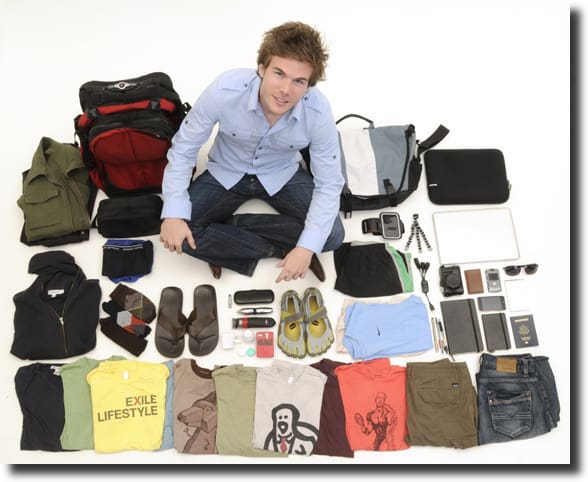
To this extent, Jon Yongfook, a digital nomad who founded a social media software company while traveling to multiple Southeast Asian countries, explained:
Just living this lifestyle for a couple of months, you entirely re-evaluate how much you need to live and have a fulfilling life.
Yes, we all want to be rich, we all want to earn $100k a month lazing on a beach – and perhaps that’s your ultimate digital nomad end goal and there’s absolutely nothing wrong with that (that’s the direction I want my business to go in too!).
But to sustain a beach-going, nomadic lifestyle, you actually don’t need anything anywhere near that.
Don’t believe the hype. Living like a digital nomad is cheap, especially if you are a minimalist.
Myth #3: It’s Impossible to Build a Business While Traveling
Related to the first myth, it’s easy to believe that by being constantly on the move you will have a hard time starting and (god forbid) growing a business. But, as you can imagine, this is also false.
There are countless companies that have been started and run by digital nomads. Companies like Buffer, And.Co, and Hotjar were all built by remote workers around the world.
Breanden Beneschott, co-founder and COO of Toptal, a marketplace for top developers, explained how he was able to start and grow his company while traveling over 30 countries.
We decided to move to Eastern Europe and keep practicing what we were preaching, in terms of scaling a company via a completely distributed team.
Doing so allowed us to funnel nearly all profits back into growing the business (and live like kings for next to nothing).
We are now approx 60 team members and 1,000 engineers (e.g., top-100 Rails contributors, guys from CERN, university professors, etc.) working with thousands of clients (e.g., Beats, Zendesk, Artsy, JPMorgan, etc.) with virtually zero restrictions when it comes to location.
None of these businesses are small or unprofitable. And.co was acquired by Fiverr, Buffer has over 80 employees and boasts a monthly recurring revenue of $1.5 million, and Toptal employs 2,300 people with revenue above $100 million.
The fact that there aren’t more businesses like them isn’t proof of the ineffectiveness of nomadic entrepreneurship. Rather, it shows there aren’t enough people who try it.
Becoming a Nomadic Entrepreneur: The Digital Nomad’s Perfect Business
Being a digital nomad is a unique experience, so the challenges we face while running our businesses are unlike many of the problems typically discussed in business journals and conferences. While it’s certainly doable, there are a lot of inconveniences to overcome, both short and long term.
For this reason, digital nomad entrepreneurs run no-nonsense businesses that adapt to their circumstances. Among all the successful digital nomad-run companies analyzed here, we’ve found most share the following four attributes:
Remotely Delivered Product
The key here isn’t just that the company can be managed remotely. Technically, just about any business could. For example, with virtual communication tools like Skype and Whatsapp, you could run a bakery in New York from Los Angeles. But would that be sustainable? Probably not.
What makes a digital nomad entrepreneur able to manage their own business while traveling is the remote delivery of the final offer. If you can deliver your product without being present with your customer, you can probably run it remotely.
Think about a software company. If you sell a piece of software, what difference does it make if you develop and market it from Kuala Lumpur, Cape Town, or Buenos Aires? The fact that the delivery of the final product (the software) is done online means the final customer won’t likely care or even know about the location the business is based.
Caution: don’t try to work from a rooftop terrace like in this picture
EXCLUSIVE FREE TRAINING: Successful Founders Teach You How to Start and Grow an Online Business
The same can be said about an ecommerce business (particularly one that uses dropshipping, which we’ll discuss later), an educational company that sells digital informational products, or a services business focused on the digital world.
In a similar vein, anyone who possesses a digital-native job or skill can work remotely, assuming the company that hires them (full-time or as a contractor) can communicate efficiently with the digital nomad. Some examples of such jobs or skills include:
- Software engineering
- Data science and analytics
- Design
- Marketing
- Writing
- Video or music production
100% Bootstrapped
Another thing digital nomads have in common is that they prioritize their freedom. Their business finances are no exception, so digital nomads often self-fund their businesses, either through running side-hustles or by reinvesting any profits generated. In entrepreneurship, the term for companies forgoing investors or bank loans is bootstrapping.
Whatever you call it, the point is that digital nomads run lean, financially independent businesses. Not only is this advantageous for the founder, as they get to keep their entire stake in the business should they decide to sell it in the future, it also goes hand-in-hand with their rebellious, free-spirited attitude. The reason is more philosophical than financial.
Rob Walling, founder of Drip, explained this idea in a recent podcast:
Most investors are a lot like bosses. They require you to sacrifice working on your dream so that you can prepare slide decks; they use artificial metrics, like headcount, to measure growth. Build a real business instead of a dreamy unicorn goal.
A completely bootstrapped business allows a nomadic entrepreneur to manage it however they think it should be run. Instead of having to report to a board of investors—or even bank officers—who prioritize fast growth over anything else, a digital nomad can choose to grow their business as fast or as slow as they please. The same applies to other aspects of the business, like:
- Hiring
- Developing new features
- Tapping new markets
- Wage negotiation
- Location (obviously)
Another advantage of traveling the world while building and managing a business is that it allows digital nomads to leverage what Tim Ferriss coined in The 4-Hour Work Week as “geoarbitrage.”
Geoarbitrage allows a digital nomad to take advantage of the wage and cost disparities between two nations or cities, thus increasing one’s purchasing power. For example, $2,000 a month of net income wouldn’t allow you to live in a city like New York, but would be more than enough to live in Mexico City, Lisbon, Istanbul, Delhi, or Bali.
My digital nomad adventures: This is what happens when you work close to a paddy field
Such disparities can allow a digital nomad to fund their company, reinvesting these savings into the business, and still live a comfortable life. While many entrepreneurs are forced to eat ramen noodles and sleep in their cars, something that often happens in San Francisco, a digital nomad can live a comfy life in a more affordable country and still grow their business.
High-Margin Offers
Any business owner knows there are two elements that define the future of a company: revenue and costs. Both elements determine the business’s profits, and they can easily hamper a digital nomad’s life if they’re not taken into consideration.
While geoarbitrage lets a digital nomad lower costs and still live a good life, a company that makes little profit will turn a potential travel-friendly business into a complicated venture. You don’t want to be visiting the relaxing beaches of Da Nang while freaking out about whether you’re making enough money to sustain your life.
A high-margin product is the answer to such concerns. Instead of selling a high-revenue, high-cost product or service, it’s much easier to sell a business that generates high profit, by selling a product or service that’s relatively cheap to produce but sells at a much higher multiplier.
Four examples of high-margin products are:
Digital Infoproducts
A digital product is any kind of online-based education-focused content, including ebooks, videos, and webinars. The key element that makes digital infoproducts so attractive is that they can be created (or recorded) once and then resold indefinitely. Also, they represent an opportunity to create the ever-famous “passive income,” helping you make money while you sleep and without having to worry about closing sales yourself.
While we’re obviously biased, Foundr itself is a great example of a company that sells digital premium courses, including our popular Start & Scale course (for ecommerce entrepreneurs), 60-Day Startup (for entrepreneurs), and many others (with more to come!). While we spend a large amount to record the best quality video with top professionals in the industry, our costs are pretty much out of the way before the course launch, and after we launch, it’s all profit, baby.
Matt Kepnes, founder of Nomadic Matt, is another example of a blogger who has built his traveling lifestyle by creating a bestselling book and multiple courses related to blogging, photography, and travel.
Dropshipping
We all know starting an ecommerce store is a lucrative way of doing business online. On its own, an ecommerce business seems like the perfect digital nomad-friendly business. The delivery is often done online, it’s easy to bootstrap, it’s filled with highly niched companies in every industry imaginable, and the margins are often good.
The only challenge is the manufacturing and product development work that every new product sold can entail. When you’re just starting out, it’s a common practice for a founder to be close to the development of the product, making sure the prototypes and first runs are as close as the envisioned product. This represents a steep hurdle for most digital nomads, which is why they often focus on a specific type of fulfillment method that skips all these pains: dropshipping.
Dropshipping is where you have a manufacturer or reseller send the product you sell to your customer straight from the former’s fulfillment centers. By using the vendor’s logistic systems, you’re outsourcing most of the job an ecommerce business needs to pay attention to and you focus on the one aspect you control: marketing.
The only disadvantage of dropshipping is that it dilutes a big piece of the margins since you are having someone else take care of an essential part of your business, violating the third element of the perfect digital nomad business.
Here at Foundr, we focus more on teaching entrepreneurs how to create, design and manufacture their own products. This can also be done from anywhere in the world. If you want to learn more about how to do this, watch our free Ecommerce masterclass and read our free guide on how to start and scale an ecommerce business.
Still, many dropshipping entrepreneurs have started a nomadic lifestyle, because of the hands-off management, low overhead, and small barriers to entry. Actually, it’s almost too easy to start a dropshipping business. It takes the following steps:
- Open an account in an ecommerce platform like Shopify or BigCommerce
- Install an app like Oberlo or Dropified
- Pick your products
- Start selling
Yes, it’s that easy. If it looks too good to be true, it’s not; there are many six- and seven-figure dropshipping entrepreneurs who’ve learned how to sell consistently and create an authoritative business in the past.
Fulfilled by Amazon (FBA)
The idea of having a vendor ship your products to your customers (dropshipping) is a wonderful proposition, because it frees your time up to focus on promotion. What if you didn’t even have to do that? What if you sold to the customers of a company that already generates $178 billion per year? Then you’d be selling through the Fulfilled by Amazon (FBA) program.
The idea of FBA is straightforward:
- You manufacture or buy wholesale from a vendor
- You send your products to an Amazon warehouse
- You sell to thousands of Amazon’s existing customers and visitors
If dropshipping sounded great, then you must be drooling by now. The opportunities in this industry are huge, often filled with stories of people turning $500 into $10,000 in a few months or more.
A common case study of the success of FBA
Source
Many digital nomads have started using FBA as their main businesses. The hardest part is the manufacturing, which takes some testing and upfront costs (which can easily scale up to the mid six- to seven-figures), and the marketing, which takes optimizing the listing and carrying out an Amazon PPC campaign. Once you send your products to the warehouses, Amazon takes care of the rest.
Take a look at this in-depth guide to learn more about FBA.
Software
Software is everywhere. According to Chiefmartec, the marketing software industry has over 6,800 thousand companies. The IT, security, and finance industries have their own spaces as well.
Despite the high competition, software and digital nomads are a match made in heaven. First and foremost, most software businesses currently bring recurring revenue, that is, you acquire a customer once and then you generate revenue over many months or years. If that sounds close to passive income, it is. Also, as stated before, you can sell software from anywhere.
The disadvantages of a software business, however, are the costs of development and marketing. Web developers are among the best-paid jobs in the US, with an average annual wage of $149,730. At the same time, promoting a software business isn’t easy, particularly if the price of the product goes above the low-end of the spectrum (around $30).
Regardless of these disadvantages, there are many successful software companies run by digital nomads. I already mentioned the case of Moo.do, Buffer, Hotjar, and Toptal. There are many more, who were either built or have hired digital nomads.
According to Alex Turnbull, founder and CEO of Groove, “remote working is a skill like any other, and sometimes an employee who isn’t at their best simply hasn’t focused on working on that skill yet.”
Services
A service business is probably the easiest way to become a digital nomad. It only takes a few clients that pay you enough to travel the world (the amount to consider as a minimum will depend on your destination, a topic which we’ll discuss later) and you’re done.
Nicole Faith makes between $150,000 to $200,000 running the branding and design agency 10 Carat Creations while traveling the world. In a Fast Company interview, she said, “success can happen in weeks or months. You have to be willing to put in the unpaid hours to reap the rewards later on.”
Niched
By now, you probably know that behind every digital nomad business, there’s efficiency (or what the startup world calls “being lean”). Besides geoarbitrage, high-margin offers, and their remote delivery, the final point of the perfect digital nomad business is its market specificity—what’s commonly known as a “niche business.”
The whole purpose of having a niche business is that it makes marketing much easier. While the market shrinks, the power of the marketing message increases. No one will stop you from trying to sell beard oil products, but making it focused on African-Americans, which is what Gamal Codner (a successful Start & Scale student) did with Fresh Heritage, will make it much easier to sell to your target audience.
Behind pretty much every digital nomad, there’s a niche business, whether that’s product- or service-based. Take the case of Kristin Addis, a former investment banker from Southern California, who after growing tired of her intensive but lucrative job, quit to start selling solo adventure travel tours and infoproducts to women.
Such specificity makes running a digital nomad business easier. Add to that the other three attributes mentioned above, and you have a perfect business to run from anywhere in the world.
EXCLUSIVE FREE TRAINING: Successful Founders Teach You How to Start and Grow an Online Business
How to Become a Digital Nomad and Build a Business While Traveling the World
Building a business that adapts to your travels is still similar to building a “traditional” location-dependent one. The main difference is the fact that you get to save more money, gain fulfilling new life experiences, and learn new skills.
Instead of teaching you how to launch a new business—something we’ve covered in our Ultimate Guide on Starting an Online Business—we’ll focus the rest of this guide on helping you prepare to launch your digital nomad life while starting to build your business on the go.
Step 1: Define a Budget
When you start traveling, you’ll find it will be very easy to spend money on unnecessary activities, food, or products you don’t need. Everything will seem new and exciting, and you will want it. To overcome such temptation, start with a budget.
Your budget will depend on the city you decide to travel to. Since you are (or will be) building a new company, you want to spend as little as possible while still enjoying the rewards of geoarbitrage explained above, so you can reinvest everything in your business.
Start by looking at sites like NomadList and The Earth Awaits to find a list of cities where you’d like to live. As shown above, both sites give a detailed breakdown of the costs of living, including:
- Rent (both short-term and long-term)
- Food
- Transport
- Air tickets
- Eating out
- Coffee shops
- Coworking
- Gym
I can’t recommend any particular city you should consider, as that will depend on your needs and interests. If you want to meet other digital nomads, cities like Chiang Mai and Lisbon are two good options. If you want to surf, Cape Town is your best bet. If you want to network with tech entrepreneurs, Berlin and Barcelona are two relatively inexpensive cities. The same can be said about any other interest you have.
Or if you want to chill, St. Kitts is always a good option 😅
The point is you pick a city you would like to live in and enjoy. Also, aim to live for at least a month in each city, if not three, so you can:
- Negotiate better terms for short-term lease agreements
- Have more time to focus on your business
- Have the time to meet new people and build a life in a new place
- Live your life slower and enjoy it more
To this extent, Cassie & Shay, two entrepreneurs who run the blog Bucketlist Bombshells, have explained:
We’ve realized that it’s not a race (what a concept!) and that we actually enjoy settling into a new city for at least 3 months to truly get to know the local culture. It’s also waaay better for the growth of our businesses.
If you need more information, you can ask in the Digital Nomad subreddit or in Facebook groups built around different locations, like the one for Chiang Mai or Medellin.
You can also rely on good old Google, which will show you blog results from people who have lived in the city or country you are interested in.
Step 2: Start Saving Money Before You Start
Geoarbitrage will help you save more money than you’d spend if you lived in a large city in a country like the United States, Europe, or Australia. If you keep your current income and move to a cheaper city, you’ll have instantly saved a lot of money.
Nonetheless, it’s much better if you start saving money before you start your traveling life. You’ll be growing a business, after all. If you are worried you won’t be able to sustain yourself, you’ll spend mental and emotional energy on something that will distract you from your business.
Having a financial cushion will give you peace of mind and a willingness to invest more in your business, knowing you can make do if your revenue slows down.
Create a savings account with your bank of choice and set up automatic withdrawals to it. Aim to save at least twice your budget. For example, if your budget is $2,000 per month, save at least twice that amount before your travels begin.
You can also use services like Qapital and Digit, which help you save based on rules, budget amount, and much more.
On top of that, consider opening an internet-only bank account, which provides high-interest saving rates, with annual yields many times greater than the ones from standard banks. Some of these high-interest banks are:
- Ally (United States)
- Marcus (United States and United Kingdom)
- RaboDirect (Australia, New Zealand, and Ireland)
To save more money, consider selling all your non-essential belongings you will not take with you. Travel will force you to become much more conscious of your belongings. It’s both expensive and annoying to walk around the stone-paved European streets (if not dirt roads in some Asian and Latin American cities) with multiple heavy pieces of luggage. The space and weight you save will also translate into extra cash, which you can use to bolster your savings account.
Step 3: Build Your Business
The previous two steps were all about organizing your life prior to starting your business. I left the most important (and obvious) step for last for two reasons:
- It’d take a whole new article to explain how to do it, and even still, it would depend on the kind of business you want to start.
- I wanted to focus more on the steps you need to take specifically to start enjoying your digital nomad lifestyle.
Because you need to pick a business that fits the four attributes of the perfect digital nomad business, I will share a few useful resources that will help you get started with each recommended type. You’ll recognize the categories from the previous section.
Consulting
The easiest business to start is the one that depends on your skills and your skills alone. All you have to do is to promote yourself in a way that lets you build a business around those skills. Easier said than done, unfortunately.
To become a profitable consultant, you need to master more skills than your own, including learning how to close deals, charge the right price, and pick up new clients consistently. The good news is, these are all things you can learn!
Here are some guides that will help you with each of these points:
- How to Become a Confident, In-Demand Consultant, Coach, or Freelancer
- How to Close a Deal With a Big Client: Get Even the Most Resistant Prospect to Say ‘Yes’
- How Much Should I Charge as a Consultant? Setting the Right Price for the Value You Offer
- Should I Start a Consulting Business? How to Know if You’ve Got What it Takes
- The Complete Guide to Getting Clients for Your Consulting Business, from Finding Prospects to Sealing the Deal
Dropshipping and FBA
As you saw before, starting a dropshipping store is relatively easy path to get started in ecommerce. While the steps look really easy to implement, remember that a lot of people are doing them. If you want to start a successful dropshipping store, make sure to pick a market that you understand and that you’re passionate about. What separates the winners from the losers is marketing. If you know and love your niche, it will be much easier for you to promote it.
With that said, the following guides will help you get started:
- How to Start a Dropshipping Business
- How To Start a Dropshipping Business In a Week
- The Ultimate Guide to Dropshipping
If you want to manufacture your own products instead of dropshipping, watch our free Ecommerce masterclass and read our free guide on how to start and scale an ecommerce business.
The process of starting an FBA business works similarly to launching a dropshipping one. The largest difference is that you often need to make a large initial investment to get started—unless you pick a cheap product and a small initial order, which will put you in competition with hundreds of low-budget entrepreneurs and lower your margins.
For that reason, the research and negotiation phase is critical. Also, you need to learn to find the right manufacturer and the basics of importing from China (the most common manufacturing location) to the US, which isn’t as simple as you may originally think.
The following guides will help you get started on your journey:
- How to Sell on Amazon: The Ultimate (Step by Step) Beginner’s Guide
- How to Start an Amazon FBA Business
- How You Can Make Big Money Importing From China – The Rise and Fall of My Empire…
- How to Find a Manufacturer or Supplier for Your Product Idea
Software
Starting a software business isn’t as straightforward as the previous three business types. You can easily consider a platform a “software” program, just like a mobile app or a game. For that reason, we’ll focus on a SaaS web app business, something along the lines of Buffer or Hotjar, two popular and successful remote software companies.
- Here’s How I Built and Launched a SaaS Company For Less Than $40k
- The Critical Lessons I Wish I Had Known About Before Starting a Software Company
- The Essential Guide to Growing Your Early-Stage SaaS Startup
Digital Products
Behind every successful business that sells digital products, there’s an engaged community. Foundr is a great example of such company with a large community. As I said before, we sell different premium courses, but we sell them thanks to having built a website with over 200,000 monthly visitors, 1.5 million Instagram followers, and many more email subscribers.
Joanna Wiebe from Copy Hackers is another example of an entrepreneur with a large audience. She has a highly invested community of writers, copywriters, and marketers who follow her thanks to the amazing advice she gives out.
In order to sell digital products, however, you don’t need over a million visitors a month or 50,000 subscribers. A small list can work just as well as a large one.
To start selling digital products, these guides will help you:
- How to Make Money With an Awesome Online Course: The Complete Guide
- Your Guide on How to Make Money With eBooks
EXCLUSIVE FREE TRAINING: Successful Founders Teach You How to Start and Grow an Online Business
Become a Digital Nomad
Digital nomads sometimes get a bad rap. People often suspect they lie about all day sipping margaritas on a tropical beach.
As you saw today, this couldn’t be further for the truth. The fact that you travel while you work doesn’t change anything—it merely frees you up from the geographical bonds of the traditional workplace.
What all digital nomads have in common is an interest in breaking out of those societal rules about work that have become largely outdated. Digital nomads aren’t interested in working from 9 to 5 in a cubicle every day for 40 years of our lives. As Ariel Camus, founder of Microverse, explains in Hacker Noon:
There is no reason why we should work 8 hours a day and take vacations once or twice a year. It’s just something we have agreed on as a society, based on the productivity levels that we want to sustain.
If you want to get started as a digital nomad and start a business that you can take with you throughout the world—whether that’s another city in your country, another country, or a whole new continent—now you know what you’ve got to do.
Save money, invest everything in your business, and work hard, just like you would in your home city.
Are you interested in becoming a digital nomad? If so, share your thoughts below, I’ll be happy to answer any questions you have!

